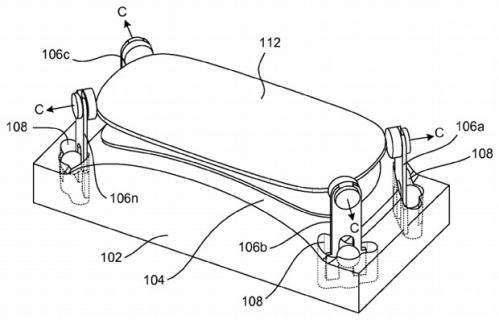December 28, 2012 weblog
Apple wins multi-touch and glass process patents

(Phys.org)—The US Patent and Trademark Office has published thirty-six patents granted for Apple. Patently Apple has highlighted two of those patents. One has to do with multi-touch displays. The multi-touch patent relates to sensor panels using capacitive sensors to detect and localize touch events. The other patent has to do with new ways to shape glass for iDevices, e.g., the iPhone and iPad. One of the advantages of Apple's proposed process on glass is that it would not involve dangerous chemicals and gasses.
First, in presenting the Touch Sensor Back Plane Ground Connection, which was filed by Thayne Miller in July last year, the patent noted that, if touch sensors are to correctly identify the presence and location of a touch event, then the back plane of the touch sensor panel needs to be reliably grounded. If the back plane isn't, then sensors may behave sporadically and misrepresent touch events or fail.
"Touch sensors may misrepresent the touch event. These misrepresentations can include, but are not limited to, errors in the location of a touch event or the detection of a phantom touch in the absence of an actual touch event. In extreme cases, the touch sensors may fail altogether." The patent said the various embodiments in the disclosure are designed to provide a reliable ground connection even in the presence of failure conditions.
Providing a reliable ground connection for the back plane may be useful in providing a uniform electrical reference point to measure changes in voltage and capacitance from a touch event. The patent signals Apple's ongoing development of multi-touch for its iDevices.
The "Glass" patent, titled "Glass alignment for high temperature processes," was filed in 2009. The patent said that "Apparatus, systems and methods for alignment of a glass member for high temperature processing are disclosed. The high temperature processing can, for example, pertain to a slumping process to mold glass into a predetermined shape (e.g., a three-dimensional shape). In one embodiment, a glass slumping system can have a mold and an alignment system that support a glass member to be slumped relative to the mold. The alignment system may have a plurality of alignment members being configured to move away from the glass member as the temperature increases during the slumping process to allow the glass member to bend around the mold without interference."
This second patent appears to have drawn the most interest from Apple watchers, casting bets that it may signal introductions of bendable phones and other such devices.
The new patent details a way to use heat to achieve a particular shape. The patent suggests ways to shape glass without having to undergo a long process and involving risky chemicals. The patent's suggested embodiments of the glass invention are discussed: "The apparatus, systems and methods for alignment of a glass member for high temperature processing are suitable for glass covers assembled in small form factor electronic devices, such as handheld electronic devices," it said, but also listed more embodiments.
"The apparatus, systems and methods can also be used for glass covers or displays for other relatively larger form factor electronic devices (e.g., portable computers, tablet computers, displays, monitors, televisions, etc.)."
© 2012 Phys.org





















